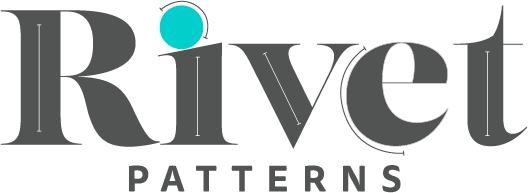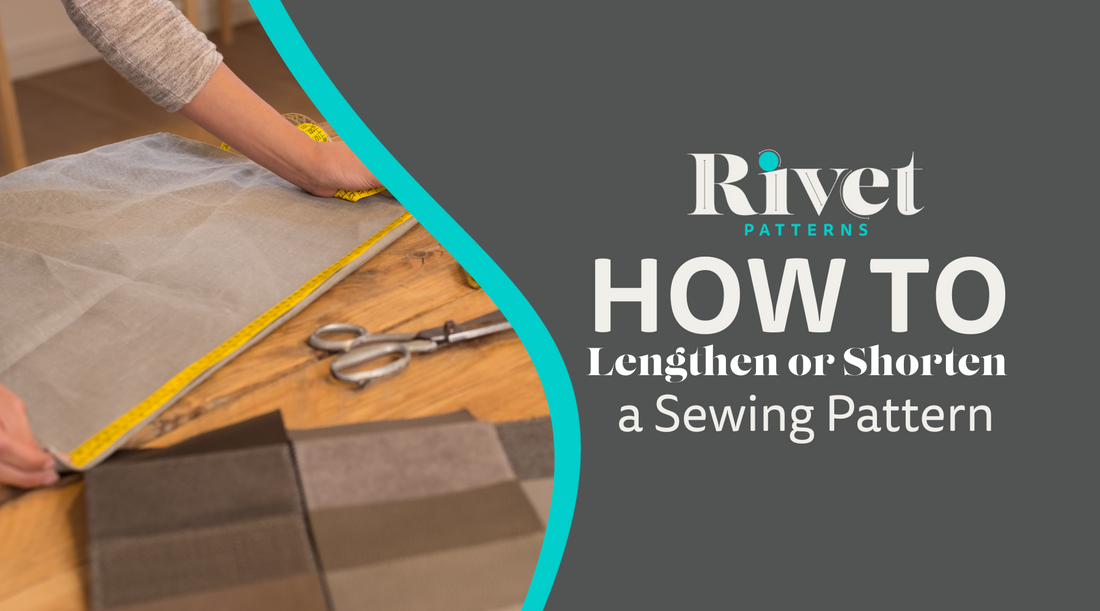Rivet Patterns How to Lengthen or Shorten a Sewing Pattern. One of the most awesome things about sewing your own clothing is you can make a garment to fit YOU. A sewing pattern is created using 'average' measurements. Just like RTW (ready to wear), an item made from that sewing pattern will fit you just as well as something you pick up at that store or at the mall. The key to a well fitting garment is to take the time to really understand what makes your body unique.
The very first adjustment to tackle is the lengthening or shortening of a sewing pattern to match YOUR proportions. I rediscovered sewing because as a tall woman, I hadn't had a one piece swimsuit since elementary school. I realized if I wanted one that fit me not only in length, but also my bust/waist/hip proportions, I was going to have to make one myself.
Height is a great starting place for altering your pattern. As I am pushing 6 feet, I know I'll have to add length. But WHERE? Even people of 'average' height have different proportions.
For example, let's take our tutorial measurement model. I'll call them Alex. All five of these Alex models are of the same 'average' height. The first Alex on the left has 'average' proportions. Alex #2 has an average inseam, but is high waisted. Conversely, Alex #3 also has an average inseam, but is low waisted. Alex #4 has an average waist, but a longer inseam. While Alex #5 has an average waist with a shorter inseam.

With all these proportion combinations, how do you know where to adjust? I would bet you already have a pretty good idea where to start based on your current clothing. Do you constantly tug your shirt down? Do you have to roll up your sleeves all the time?
When adjusting a sewing pattern, there are a handful of common places to add or subtract height. You may want to further adjust specific options of a pattern such as a hood or a pocket. The method is exactly the same. We are going to work our way down: armscye/sleeve cap, sleeve, waistline, top hem, rise, knee, and inseam. NOTE: I am using the front bodice/pant/skirt, but you will need to make the exact same adjustments on the back bodice/pant/skirt so that your side seams line up.

ARMSCYE
Before we get started on the armscye and sleeve adjustments, there are a few non-height adjustments you'll need to address first. If your armpit feels uncomfortably high, you may have a longer neck to bust point than average and need to add length. OR you might need a full bicep adjustment or a broad shoulder adjustment. To check if a full bicep adjustment is needed, measure around the fullest part of your upper arm and compare it to the bicep measurement in the size chart. To check if you need a broad shoulder adjustment, raise your arm wearing your muslin. The crease where your shoulder and arm come together is where the seam of a set-in sleeve should be. If you find this to be a bit short, lengthen the shoulder line first.
Conversely, if your armscye gapes, you might have a shorter neck to bust point than average and need to remove length. OR if your sewing cup (not bra cup) size is greater than a B cup (2" difference in your high bust to full bust measurements), you might need to start with a Full Bust Adjustment.
Place your bodices and sleeve piece lined up at the under arm. Draw a horizontal line through the sleeve cap, armscye and center front and cut. In some bodices, this will also change the front neckline. You can reprint/project the original neckline to trace on to your new pattern piece or leave it as is and recalculate the neckband.

To lengthen: Spread your pattern pieces apart the amount that you want to add. A little bit goes a long way here so start small. Place paper behind your pieces and gently redraw your lines.

To shorten: Overlap your pattern pieces by the amount you want to remove. A little bit goes a long way here so start small. Gently redraw your lines.

SLEEVE
Sleeves generally only have one lengthen/shorten line somewhere in the middle. That will get you in the ballpark, but if you want a more accurate sleeve so that the elbow ends up in the right place, split the amount you are adding/subtracting and add half of it in the bicep and the other in the forearm.
Draw horizontal lines through the bicep and forearm of your sleeve pattern piece and cut.

To lengthen: Spread your pattern pieces apart the amount that you want to add. Place paper behind your pieces and gently redraw your lines.

To shorten: Overlap your pattern pieces by the amount you want to remove. Gently redraw your lines.

TOP WAIST AND HEM LENGTH
Next on down is adjusting the waistline. Generally speaking, the waistline of a garment is the smallest part and should match the smallest part of your torso. To find your natural waist, tie a piece of elastic around your middle and do a few 'I'm a little teapot' moves. The elastic will migrate to your waistline, roughly even with your elbows. From there, you'll want to check the hem length. If you are adding or subtracting more than 1" to the overall bodice length, you'll want to distribute it evenly by making more than one cut.
Draw horizontal lines a couple of inches above the waistline and around the high hip line of your bodice pattern piece and cut. You will repeat this adjustment at the same place on the back bodice.

To lengthen: Spread your pattern pieces apart the amount that you want to add. Place paper behind your pieces and gently redraw your lines.

To shorten: Overlap your pattern pieces by the amount you want to remove. Gently redraw your lines.

PANTS RISE
Rise is one of those things that is affected by body shape and where your weight is carried. We go in to the front and back rise individually in more depth in the Sewing Pattern Pants Fitting blog post. Here, we are going to address the overall rise that is directly related to height proportions.
Draw a horizontal line directly through the rise of your pants and cut. If there is a hipline marker, make your line above the hipline. You will repeat this adjustment at the same place on the back pants piece. If your pattern has pockets, you may need to adjust those pieces as well.

To lengthen: Spread your pattern pieces apart the amount that you want to add. Place paper behind your pieces and gently redraw your lines.

To shorten: Overlap your pattern pieces by the amount you want to remove. Gently redraw your lines.

PANTS KNEE AND INSEAM
For the best pants fitting, use the knee line to add or subtract length proportionally. If your pattern doesn't have a knee line, split the amount between the upper and lower leg. If you are adding/subtracting more than 3", consider making a third or even fourth line to distribute the adjustments evenly.
Draw horizontal lines directly through the thigh area and calf areas of your pants and cut. You will repeat this adjustment at the same place on the back pants piece.

To lengthen: Spread your pattern pieces apart the amount that you want to add. Place paper behind your pieces and gently redraw your lines.

To shorten: Overlap your pattern pieces by the amount you want to remove. Gently redraw your lines.

FITTED AND A-LINE SKIRT HIP AND HEM LENGTH
For a fitted skirt, there are two places to adjust. The first is above the hipline and the second is the overall hem length. Depending on the length of the skirt (mini vs maxi), you might consider making your hem adjustments in more than one place.
Draw horizontal lines and cut between the waist and hiplines and between the hipline and hem. You will repeat this adjustment at the same place on the back skirt piece.

To lengthen: Spread your pattern pieces apart the amount that you want to add. Place paper behind your pieces and gently redraw your lines.

To shorten: Overlap your pattern pieces by the amount you want to remove. Gently redraw your lines.

HALF CIRCLE AND GATHERED SKIRT
Looser fit skirts are a little easier to adjust. You can usually get away with a singular cut somewhere in the middle. For a gathered skirt, it begins as a rectangle so you can add or subtract your length anywhere. For a half circle skirt, if you are adjusting more than 3" of length, you might consider doing so in more than one place to make redrawing the side seam smoother.
Draw a horizontal line and cut between the waist and hem. You will repeat this adjustment at the same place on the back skirt piece.

To lengthen: Spread your pattern pieces apart the amount that you want to add. Place paper behind your pieces and gently redraw your lines.

To shorten: Overlap your pattern pieces by the amount you want to remove. Gently redraw your lines.

FULL CIRCLE SKIRT
Because circle skirts are usually exclusively based on waist size, adjusting length is a little different and only done at the hem line.
To lengthen: Extend the line at each side seam by the amount you want to add. Measure and add that amount at several points along the skirt hem. Draw your new line.

To shorten: Mark the line at each side seam by the amount you want to subtract. Measure and subtract that amount at several points along the skirt hem. Draw your new line.

Woohoo! Look at that. Your pattern is now long or short enough for YOU. Next up, let's talk about grading. Do your measurements put you into different sizes? Learn how to grade for YOUR body!
Happy Making!
Rachelle


2 comments
Hello Marilyn! Yes. If you lengthen the pattern above the waistline, it will also move the hipline down. The pattern will still be the same distance from waist to hip (approximately 8"), but lengthening above will move everything else down an inch. You can alter the hipline by lengthening/shortening between the waist and hip.
Hello. What a great blog, it is so comprehensive. May I ask though, and something I still struggle with, if I lengthen to make the pattern match my waist will that alter where the hip lands? Will the hip on the pattern be lower down? Thank you.